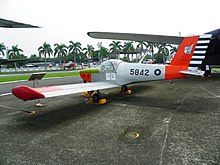Pazmany PL-1
| PL-1 Laminar/Cheinshou and PL-2 | |
|---|---|

| |
| Pazmany PL-2 at Winter Haven Airport, Florida, in 2011 | |
| Role | Two-seat trainer |
| Manufacturer | Pazmany Aircraft Corporation |
| Designer | Ladislao Pazmany |
| First flight | 23 March 1962 |
| Primary users | Republic of China Air Force Indonesian Air Force |
The Pazmany PL-1 Laminar and Pazmany PL-2 are American two-seat trainer and personal light aircraft designed by Ladislao Pazmany to be marketed as a homebuilt aircraft by his company Pazmany Aircraft Corporation. The aircraft was built under license in Taiwan (Republic of China) as the AIDC PL-1B Cheinshou. It was later followed by an improved version the PL-2. The SLAF Aircraft Engineering Wing developed a modified variant of the PL-2 in 1977, which never saw combat but was used in air shows.
Development[]
The PL-1 Laminar was the first design by Ladislao Pazmany, it was intended to be marketed for the homebuilt market. The prototype first flew on the 23 March 1962. The PL-1 is a cantilever low-wing monoplane with a fixed tricycle landing gear. It has side-by-side seating for a crew of two and is powered by a 95 hp (71 kW) Continental C-90 piston engine. The Aerospace Industrial Development Corporation (AIDC) acquired plans and built a PL-1 for evaluation with a first flight on 26 October 1968. AIDC then built 58 aircraft designated the PL-1B for the Republic of China Air Force and fitted with a 150 hp (112 kW) Avco Lycoming O-320 engine.
Soon after the first flight Pazmany produced an improved design, the PL-2 which had a slight increase in cockpit width and changes to the structure to make it easier for homebuilders. The PL-2 was evaluated by a number of air forces in South East Asia. It was built under license in Indonesia as the LIPNUR LT-200.
Variants[]

- PL-1
- Original design for home-built light aircraft
- PL-1B
- License-built variant by AIDC with a 150hp (112kW) Avco Lycoming O-320 engine, 58 built. Known as the PL-1B Chieh Shou.
- PL-2
- More rounded, wider cockpit, increased wing dihedral.[1][2]
- PL-2A
- Improved model, all metal, two seats[3]
- LT-200
- License-built variant by LIPNUR in Indonesia, 4 were built.[4]
Operators[]

- Indonesian Air Force - LT-200 (Licensed-built PL-2)
- Republic of Vietnam Air Force - One aircraft only, no longer in service. Named the Tien Phong "Pioneer", built under U.S supervision. Plans for additional aircraft were cancelled in 1972[5]
- Republic of China Air Force - PL-1, PL-1A, PL-1B
- Republic of China Army - PL-1B
Former Operators[]
- Sri Lanka Air Force - Sri Lankan built PL-2 variants were in operation until the early 1980s.
Specifications (LT-200)[]
Data from The Illustrated Encyclopedia of Aircraft (Part Work 1982-1985), 1985, Orbis Publishing, Page 2694
General characteristics
- Crew: 2
- Length: 19 ft 3.5 in (5.88 m)
- Wingspan: 28 ft 0 in (8.53 m)
- Height: 7 ft 7 in (2.31 m)
- Wing area: 116.0 sq ft (10.78 m2)
- Empty weight: 904 lb (410 kg)
- Gross weight: 1,609 lb (730 kg)
- Powerplant: 1 × Avco Lycoming O-320-E2A flat-four piston , 150 hp (112 kW)
Performance
- Maximum speed: 152 mph (245 km/h, 132 kn)
- Endurance: 5 hours 30 minutes
- Service ceiling: 14,995 ft (4,570 m)
References[]
| Wikimedia Commons has media related to AIDC PL-1. |
- ^ Air Trails: 18. Winter 1971. Missing or empty
|title=(help) - ^ Bayerl, Robby; Martin Berkemeier; et al: World Directory of Leisure Aviation 2011-12, page 114. WDLA UK, Lancaster UK, 2011. ISSN 1368-485X
- ^ Tacke, Willi; Marino Boric; et al: World Directory of Light Aviation 2015-16, page 120. Flying Pages Europe SARL, 2015. ISSN 1368-485X
- ^ "Kunjungan Pazmany ke Lipnur". aviahistoria.com (in Indonesian). 6 March 2021. Retrieved 11 March 2021.
- ^ Air Progress: 77. December 1971. Missing or empty
|title=(help)
- The Illustrated Encyclopedia of Aircraft (Part Work 1982-1985), 1985, Orbis Publishing, Page 2694
- 1960s United States civil utility aircraft
- Pazmany aircraft
- AIDC aircraft
- Military trainer aircraft
- Single-engined tractor aircraft
- Low-wing aircraft
- Aircraft first flown in 1962